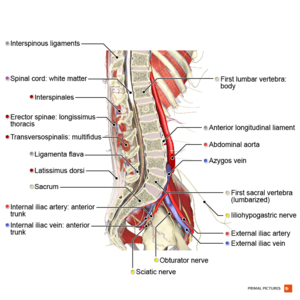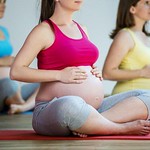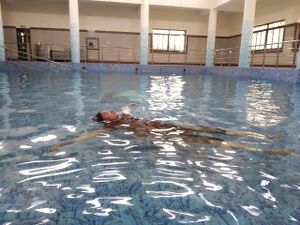The Management of Low Back Pain in Pregnancy
Introduction[edit | edit source]
Around 45% and 75% of pregnant women are said to experience low back pain at some point during their pregnancy, [1] this type of low back pain can be present in the pelvic girdle, between the posterior iliac crest, gluteal fold and/or in the general lumbar spine region.[2] It is thought to occur due to hormonal, circulatory and mechanical changes and as a result, the quality of life of the pregnant woman is affected. [3]
Prenatal is a period of time prior to birth, this is a critical phase for fetal development; therefore, it is important that the mother’s nutritional needs are met to ensure the health growth of the embryo or fetus. [4]
The term Postpartum (also known as postnatal) refers to the first six weeks immediately after birth of an infant, [5] this is a significant phase in the mothers and babies’ lives, it’s the period of adjustments to parenthood and the start of life long bond within the family and the wider community.
Epidemiology[edit | edit source]
The global prevalence is high yet ranges from 25-90% in the United States of America, Europe and some regions of Africa, with the highest rates recorded in Brazil and Sweden. This is because there is currently no universally recognised classification system for the condition.[6] It usually occurs in the second trimester (gestational 22 week average), although pain continues for up to three years in 20% of women postpartum.[7] It is estimated that 1/3 of women will suffer from severe pain, reporting that 80% impacts their quality of life, sleep and 10% causing an inability to work. A cross-sectional study consisting of 400 pregnant women found that 75.3% experienced LBP, reporting a mean Visual Analog Scale (VAS) score of 4.91 ±1.88. Despite a sufficient sample size, the generalisability is limited and the classification of pain, type and localisation were subjectively assessed. [8]
Aetiology[edit | edit source]
The aetiology is poorly understood due to the multifactorial nature, but suggested theories are associated with biochemical, vascular and hormonal changes during pregnancy. Although no true consensus regarding the risk factors, those most common include, young age, pelvic trauma, 'hunchback' posture, gestational weight gain, chronic LBP and previous history of LBP in pregnancy.[9]
Management Techniques[edit | edit source]
Various non-pharmacological Rx options[edit | edit source]
Back pain in pregnancy is treated differently depending on the stage of pregnancy, the underlying cause, aggravating factors and the involvement of other medical conditions such as diabetes or heart problems.
Postural correction [10]
- Supported side-sleeping
- Lumbar roll while sitting
- Limiting standing and walking
Antenatal exercises
- Healthy pregnant women can exercise for at least 150 minutes per week or 20-30 minutes of moderate to intense aerobic activity [11]
- Aquatic therapy
- Acupuncture [12]
- Yoga
Any low intensity, relaxation activity
Yoga[edit | edit source]
Yoga is a form of complementary and alternative medicine, incorporating fluid transitions of poses to promote increased joint range of motion, flexibility, muscular strength and balance. This is coupled with deep breathing exercises and meditation to facilitate mental relaxation, concentration and introspection.[6] Yoga is widely recognised having 300 million people practicing worldwide, encompassing 7% of women during pregnancy. It is a low impact and easily modifiable exercise, being suitable for pregnant women.[13] It has found to be effective in managing LBP during pregnancy, thought to have a similar mechanism of action for those with non-specific LBP, though with minor modifications.[6] Despite current gaps in the literature, interest and awareness is growing due to effects on quality of life and societal costs such as, days lost at work, disability payments and workers' compensation.[14]
A Cochrane Review investigated various interventions for preventing and treating low back and pelvic pain during pregnancy. This included 34 randomised controlled trials (RCTs) consisting of 5121 pregnant women aged 16-45 years old. Primary outcome measures were pain intensity, back or pelvic related functional disability, sick leave and adverse effects. Two authors independently assessed studies and disagreement resolved through consulting a third assessor. It revealed that an 8-12 week exercise programme with yoga poses reduced the risk of pregnant women reporting LBP by 44% and sick leave by 24%. Overall, it was regarded as low quality due to heterogeneity in study designs and varied results, precluding the ability to pool data. Additionally, publication bias and selective reporting were unable to be ruled out. Further research is required to ensure confidence in utilising this treatment option.[6] However, this has been disputed by a systematic review recently conducted by Koukoulithras et al. (2021) finding that yoga was not effective to improve long-term pregnancy related LBP nor statistically significant. But, the small population sample size limited conclusions able to be drawn.[15]
A RCT of 60 pregnant women ranging from 14-40 years old found that 1 hour of Hatha yoga practice per week for 10 weeks significantly lowered lumbo-pelvic pain on the VAS (p<o.0058) compared to postural orientation exercises. Also, lumbar pain provocation tests showed a gradual decreased response throughout the sessions.[16] Yoga was shown to be of most benefit in women suffering from LBP coupled with anxiety, depression, stress and sleep disturbances. Also, associated with more comfort and shorter duration of first stage labour.[13] It concluded that yoga is a safe and fetal tolerated therapeutic intervention for LBP in both first time and higher risk pregnancies, with no adverse events reported.[16]
These findings are in accordance with a Systematic Review (SR) of 15 articles including 2566 participants meeting the inclusion criteria to evaluate the literature about non-pharmacological, easily accessible management strategies for pregnancy-related LBP. The types of Yoga were Iyengear-based, Hatha and modified yoga based, incorporating progressive muscle relaxation as a tranquillity aspect. Findings indicated that 8 weeks of yoga for 20 minutes twice daily showed statistically significant improvements in LBP, with additional improvements in mental health, physical and social function. It was suggested that starting the intervention early in pregnancy shows the greatest effect. Though results variability highlighted the need for more well-designed research, conducted in 8 different countries meaning inferences can be globally recognised. Future studies should identify the frequency and duration, objective endpoints, health effects on the fetus and long-term benefit.[14]
Pilates[edit | edit source]
Pilates is defined as “a mind–body exercise that focuses on strength, core stability, flexibility, muscle control, posture and breathing. [17] Pilates was created in the 1980’s by Joseph Pilates, a German exercise instructor. [18] He originally developed this exercise method using bed springs attached to the end of beds to help his bed bound patients and soon realised that added resistance helps with increased muscle strength.[18] The following table adapted from Latey’s 2002 article “Updating the Principles of the Pilates Method – Part 2” outlines the traditional principles of Pilates: [19]
| Traditional Principle | Definition |
|---|---|
| Centring | The main focus of Pilates, the centre, “powerhouse” or core. This is the tightening of the muscular centre of the body located between the ribcage and the pelvic floor during exercise. |
| Concentration | The mind guides the body. Cognitive attention is required to perform the exercise. |
| Control | The work of exercise is being done from the centre. It is close management of posture and movement during exercise. |
| Precision | The accuracy of the exercise technique. Common saying in Pilates: “It is not how many, but how.” |
| Flow | The smooth transition of movements within the exercise sequence. |
| Breathing | All exercises to be done with a breathing rhythm in order to get oxygenated blood to all tissues of the body. Moving air into and out of lungs in coordination with exercise. |
Evidence Behind Pilates[edit | edit source]
There have been many studies into the effects of Pilates on low back pain, however there is limited evidence around its effects on LBP as a result of pregnancy.
In a systematic review completed in 2015, it was found that Pilates is an effective intervention to use in the treatment of chronic low back pain. [20] This was not pregnancy specific, however the study states that Pilates helps with postural control movement and lumbar stabilisation which in turn decreases low back pain. [20] These findings can be applied to pregnant women with low back pain as participants were all experiencing chronic LBP, which has a duration of over 3 months. [20]
In a study analysing Pilates for women's health, strong evidence was found to determine that Pilates was an effective method for the reduction in low back pain and improvement in lower extremity strength. [21] This study also stated that Pilates is effective in alleviating the discomforts of pregnancy such as low back pain, and assisting in strength and endurance for labour and birth. [21]
In a randomized control study completed in 2021 by Sonmezer et al, it was found that not only was low back pain significantly improved, however, functional disability, sleep, mobility and lumbopelvic stabilization also improved. The group completed Pilates based exercises twice a week for eight weeks and results showed that pain and disability significantly improved. In the control group, no significant improvements were seen; back pain improvements were measured using the Oswestry Low Back Pain Questionnaire. [22]
Frequency and Duration[edit | edit source]
The frequency and duration of Pilates based exercise varies depending on the study read and therefore frequency and duration can be up to the discretion of the patient.
An experimental study investigating the effects of Pilates versus regular exercise in LBP in pregnant women found that 70-80 minutes of Pilates one day, once a week for eight weeks was sufficient to reduce overall pain rates in these women. [23]The studied routine consisted of 10 minutes of warm-up, 50-60 minutes for the main workout and 10 minutes of cool down. [23]
In a randomised clinical trial, pregnant women completed an eight week Pilates programme consisting of 2 sessions a week of 40-45 minutes in total. [24] The layout of this class was different with it consisting of verification of posture, warm-up phase (5-8 minutes), aerobic and toning phase (25-30 min), flexibility phase (5-10 minutes) and then finally a relaxation phase (5-10 minutes). The women taking part in this programme also noticed a wide array of benefits. [24]
While these are good baselines to follow, the American College of Obstetricians and Gynaecologists recommends that pregnant women should exercise for at least 30 minutes daily, in the absence of medical or obstetric complications. [21] The ACOG acknowledges that Pilates can be an effective type of exercise to meet guidelines due to its strength training aspects. [21]
Positions to be Avoided[edit | edit source]
In a study completed by Mazzarino, Kerr and Morris in 2018 there were a few Pilates exercises and positions which were recommended to be avoided or modified by pregnant women. These include: modification of abdominal exercises; this is to avoid significant divarication of the rectus abdominus muscle which can be split from pressure from the uterus. Flexion should be performed while seated to avoid this. [25]
Exercises in the supine position should be avoided as it can prevent and obstruct venous return due to the growing uterus compressing the vena cava; this can cause the mother to feel dizzy. Positions can be modified to include side-lying, seated or standing exercises. [25]
This study also found that opinion of Pilates instructors on the type of exercises to be included and excluded and the average duration and frequency was discordant with the advice from The American College of Obstetricians and Gynecologists (ACOG) published in 2015. [25]
Example Pilates Programme[edit | edit source]
A booklet of recommended Pilates exercises to complete for Women's Health was compiled by Pelvic Obstetric, Gynaecological Physiotherapy. It is recommended as all of the Physiotherapists involved are CSP registered and prenatal and antenatal advice was included.
Pre-Pilates Safety[edit | edit source]
Guidelines published by the American College of Obstetrics and Gynaecologists have stated that women experiencing a normal pregnancy and have been previously healthy are safe to continue or start regular physical activity including Pilates. Prior to exercise, it is a good idea to check with your obstetrician or other member of a health care team at one of the early prenatal health visits. [26]
Manual Therapy Techniques[edit | edit source]
There is a growing evidence in support of the use of manual therapy as a safe treatment to effectively treat low back pain, especially massage and spinal manipulation. [27]
Massage
Massage therapy can be helpful for stress relief, well-being and pain reduction among women during pregnancy, and is also used to relieve low back pain during pregnancy. [28] A small study explored the impact of deep tissue massage for low back pain in women, the intervention included twice a week deep tissue massage for 2-months; the massage included: appropriate pressure, lengthening movements, movements in intermuscular grooves, anchor and stretch technique and releasing muscle tension and found it decreased pain and improve functionality of the pregnant participants. [29]
Spinal Manipulation
A systematic review was conducted in 2017, which explored osteopathic manipulative treatment/ spinal manipulation therapy for low back pain during and after pregnancy, and it was concluded that it had a significant medium-sized effect on decreasing pain and increasing functional status in women with low back pain during pregnancy, but had low-quality evidence that it decreased pain and functional status postpartum. [30] Additionally, it was found that there are physical and mental health benefits and can minimise pharmacological treatment options for low back pain. [31]
Aquatic Therapy[edit | edit source]
Aquatic therapy utilises the beneficial properties of water and has been used as a treatment method for the management of lower back pain. There is limited evidence in its effectiveness in the management of lower back pain during pregnancy, however it is still used as a treatment method.
A small scale prospective quantitative study conducted in Australia found aquatic physiotherapy sessions reduced low back pain in 70% of participants. Exercises included focused on thoracic mobility, transverse abdominus and pelvic floor muscle strengthening aiming to improve core stability and a component of aerobic exercise to maintain general fitness.[32] A systematic review concluded that there was sufficient evidence to suggest that aquatic therapy does provide some benefits to patients suffering from low back pain during pregnancy, however of the included studies all were considered to be low quality.[33]A randomised clinical trial containing 129 participants found that participants who completed 60 minute aquatic therapy classes three times a week reported reductions in lower back pain. However, reduction in back pain was a secondary outcome measure.[34]
Benefits of Exercise During Pregnancy[edit | edit source]
Maternal Benefits[edit | edit source]
- Improved cardiovascular function.[35]
- Lowers risk of developing gestational diabetes.[35]
- Improved psychological well-being.[35]
- Improvement in sleep.[35]
- Reduction in musculoskeletal pain associated with pregnancy e.g., low back pain.[35]
- Helps with weight management: excessive weight gain during pregnancy can lead to maternal complications such as hypertension, preeclampsia, and gestational diabetes.[35]
Fetal Benefits[edit | edit source]
Contraindications to exercise during pregnancy[edit | edit source]
- Persistent vaginal bleeding in the 2nd and 3rd trimester.[36]
- Cardiovascular disease.[36]
- Cervical Weakness.[36]
- History of fetal growth restriction.[36]
- History of preterm labour.[36]
- Multiple gestation.[36]
- Placenta previa after 26 weeks.[36]
- Preeclampsia or pregnancy induced hypertension.[36]
- Premature contractions or labour.[36]
- Premature rupture of membranes.[36]
- Severe anemia.[36]
- Chronic bronchitis.[36]
- Poorly controlled diabetes.[36]
- Poorly controlled seizures.[36]
- Poorly controlled thyroid disease.[36]
These contraindications are taken from the American College of Obstetricians and Gynecologists, no distinction was made between absolute and relative contraindications.[36]
Clinical Relevance[edit | edit source]
Pregnancy-related LBP is prevalent, disabling and costly to both the individual and the society. There is growing evidence in support of the use of yoga, pilates, aquatic therapy and manual therapy as a safe treatment option to effectively treat pregnancy-related LBP. Although the evidence base is of low quality, overall these management strategies are safe and recommended interventions, however further research is required to determine the extent of benefits in clinical practice. It is the responsibility of clinicians to ensure evidence-based practice when providing holistic patient centred care. Future investigations should focus on higher quality research to explore the effects of LBP in the long term and on quality of life in pregnant women.
References[edit | edit source]
- ↑ Pierce, H. (2013). Pregnancy-related low back and pelvic girdle pain : listening to Australian women. Uts.edu.au. [online] Available at: https://opus.lib.uts.edu.au/handle/10453/24033
- ↑ Katonis, P., Kampouroglou, A., Aggelopoulos, A., Kakavelakis, K., Lykoudis, S., Makrigiannakis, A. and Alpantaki, K. (2011). Pregnancy-related low back pain. Hippokratia, [online] 15(3), pp.205–10. Available at: https://www.ncbi.nlm.nih.gov/pmc/articles/PMC3306025/
- ↑ Berber, M.A. and Satılmış, İ.G. (2020). Characteristics of Low Back Pain in Pregnancy, Risk Factors, and Its Effects on Quality of Life. Pain Management Nursing, [online] 21(6), pp.579–586. Available at: https://www.sciencedirect.com/science/article/pii/S1524904220301314?casa_token=84EnmXzqlt4AAAAA:TwlY0jhc45cbQvA3yBDzsIT1-UhHmATbGJKdm8D0ojBPpm7Y1xzcXz3552qja2iMnYRAIrA
- ↑ Liu, C., Jiao, C., Wang, K. and Yuan, N. (2018). DNA Methylation and Psychiatric Disorders. Progress in Molecular Biology and Translational Science, [online] pp.175–232. Available at: https://www.sciencedirect.com/science/article/pii/S187711731830019X
- ↑ World Health Organisation recommendations on postnatal care of the mother and newborn. (2020). WHO recommendations on postnatal care of the mother and newborn. [online] Available at: https://www.who.int/maternal_child_adolescent/documents/postnatal-care-recommendations/en/
- ↑ 6.0 6.1 6.2 6.3 Liddle SD, Pennick V. Interventions for preventing and treating low‐back and pelvic pain during pregnancy. Cochrane Database of Systematic Reviews. 2015(9).
- ↑ Katonis P, Kampouroglou A, Aggelopoulos A, Kakavelakis K, Lykoudis S, Makrigiannakis A, Alpantaki K. Pregnancy-related low back pain. Hippokratia. 2011 Jul;15(3):205.
- ↑ Berber MA, Satılmış İG. Characteristics of Low Back Pain in Pregnancy, Risk Factors, and Its Effects on Quality of Life. Pain Management Nursing. 2020 Dec 1;21(6):579-86.
- ↑ Manyozo S. Low back pain during pregnancy: prevalence, risk factors and association with daily activities among pregnant women in urban Blantyre, Malawi. Malawi Medical Journal. 2019 Oct 1;31(1):71-6.
- ↑ Schröder, G., Kundt, G., Otte, M., Wendig, D. and Schober, H.-C. (2016). Impact of pregnancy on back pain and body posture in women. Journal of Physical Therapy Science, [online] 28(4), pp.1199–1207. Available at: https://www.ncbi.nlm.nih.gov/pmc/articles/PMC4868213/
- ↑ Ferrari, N. and Graf, C. (2017). Bewegungsempfehlungen für Frauen während und nach der Schwangerschaft. Das Gesundheitswesen, [online] 79(S 01), pp.S36–S39. Available at: https://pubmed.ncbi.nlm.nih.gov/28399584/
- ↑ Bishop, A., Holden, M.A., Ogollah, R.O. and Foster, N.E. (2016). Current management of pregnancy-related low back pain: a national cross-sectional survey of UK physiotherapists. Physiotherapy, [online] 102(1), pp.78–85. Available at: https://www.sciencedirect.com/science/article/pii/S0031940615037712 .
- ↑ 13.0 13.1 Babbar S, Shyken J. Yoga in pregnancy. Clinical Obstetrics and Gynecology. 2016 Sep 1;59(3):600-12.
- ↑ 14.0 14.1 Kinser PA, Pauli J, Jallo N, Shall M, Karst K, Hoekstra M, Starkweather A. Physical activity and yoga-based approaches for pregnancy-related low back and pelvic pain. Journal of Obstetric, Gynecologic & Neonatal Nursing. 2017 May 1;46(3):334-46.
- ↑ Koukoulithras Sr I, Stamouli A, Kolokotsios S, Plexousakis Sr M, Mavrogiannopoulou C. The Effectiveness of Non-Pharmaceutical Interventions Upon Pregnancy-Related Low Back Pain: A Systematic Review and Meta-Analysis. Cureus. 2021 Jan;13(1).
- ↑ 16.0 16.1 Martins RF, Pinto e Silva JL. Treatment of pregnancy-related lumbar and pelvic girdle pain by the yoga method: a randomized controlled study. The Journal of Alternative and Complementary Medicine. 2014 Jan 1;20(1):24-31.
- ↑ Wells, C., Kolt, G. and Bialocerkowski, A., 2012. Defining Pilates exercise: A systematic review. Complementary Therapies in Medicine, 20(4), pp.253-262.
- ↑ 18.0 18.1 Latey, P., 2001. The Pilates method: history and philosophy. Journal of Bodywork and Movement Therapies, 5(4), pp.275-282.
- ↑ Penelope, L., 2002. Updating the principles of the Pilates method—Part 2. Journal of Bodywork and Movement Therapies, 6(2), pp.94-101.
- ↑ 20.0 20.1 20.2 Patti, A., Bianco, A., Paoli, A., Messina, G., Montalto, M., Bellafiore, M., Battaglia, G., Iovane, A. and Palma, A., 2015. Effects of Pilates Exercise Programs in People With Chronic Low Back Pain. Medicine, 94(4), p.e383.
- ↑ 21.0 21.1 21.2 21.3 Mazzarino, M., Kerr, D., Wajswelner, H. and Morris, M., 2015. Pilates Method for Women's Health: Systematic Review of Randomized Controlled Trials. Archives of Physical Medicine and Rehabilitation, 96(12), pp.2231-2242.
- ↑ Sonmezer, E., Özköslü, M. and Yosmaoğlu, H., 2021. The effects of clinical pilates exercises on functional disability, pain, quality of life and lumbopelvic stabilization in pregnant women with low back pain: A randomized controlled study. Journal of Back and Musculoskeletal Rehabilitation, 34(1), pp.69-76.
- ↑ 23.0 23.1 Oktaviani, I., 2018. Pilates workouts can reduce pain in pregnant women. Complementary Therapies in Clinical Practice, 31, pp.349-351.
- ↑ 24.0 24.1 Rodríguez-Díaz, L., Ruiz-Frutos, C., Vázquez-Lara, J., Ramírez-Rodrigo, J., Villaverde-Gutiérrez, C. and Torres-Luque, G., 2017. Effectiveness of a physical activity programme based on the Pilates method in pregnancy and labour. Enfermería Clínica (English Edition), 27(5), pp.271-277.
- ↑ 25.0 25.1 25.2 Mazzarino, M., Kerr, D. and Morris, M., 2018. Pilates program design and health benefits for pregnant women: A practitioners' survey. Journal of Bodywork and Movement Therapies, 22(2), pp.411-417.
- ↑ Acog.org. 2019. Exercise During Pregnancy. [online] Available at: <https://www.acog.org/womens-health/faqs/exercise-during-pregnancy> [Accessed 24 May 2021].
- ↑ Oswald, C., Ceara, D., Higgins, C., Demetry, D. and Dc, A. (2013). Optimizing pain relief during pregnancy using manual therapy. [online] 59, p.841. Available at: https://www.cfp.ca/content/cfp/59/8/841.full.pdf.
- ↑ Holden, S.C., Gardiner, P., Birdee, G., Davis, R.B. and Yeh, G.Y. (2015). Complementary and Alternative Medicine Use Among Women During Pregnancy and Childbearing Years. Birth, [online] 42(3), pp.261–269. Available at: https://pubmed.ncbi.nlm.nih.gov/26111221/
- ↑ Romanowski, M.W. and Spiritovic, M., (2016). Deep tissue massage and its effect on low back pain and functional capacity of pregnant Women-a case study. Journal of Novel Physiotherapies, 6(03).
- ↑ Franke, H., Franke, J.-D., Belz, S. and Fryer, G. (2017). Osteopathic manipulative treatment for low back and pelvic girdle pain during and after pregnancy: A systematic review and meta-analysis. Journal of Bodywork and Movement Therapies, [online] 21(4), pp.752–762. Available at: https://www.sciencedirect.com/science/article/pii/S1360859217301146
- ↑ Sheraton, A., Streckfuss, J. and Grace, S. (2018). Experiences of pregnant women receiving osteopathic care. Journal of Bodywork and Movement Therapies, [online] 22(2), pp.321–327. Available at: https://www.sciencedirect.com/science/article/pii/S1360859217302310?casa_token=HSWhYgyserIAAAAA:baLVTntV0u8rBlSGt6KPKVjy4it77TYPd573TpTkyldXaOnQ7z2TLnVwNN__1qv7oOhjXzg
- ↑ Intveld E, Cooper S, van Kessel G. The effect of aquatic physiotherapy on low back pain in pregnant women. International Journal of Aquatic Research and Education. 2010;4(2):5.
- ↑ Waller B, Lambeck J, Daly D. Therapeutic aquatic exercise in the treatment of low back pain: a systematic review. Clinical rehabilitation. 2009 Jan;23(1):3-14.
- ↑ Rodríguez-Blanque R, Sanchez-Garcia JC, Sanchez-Lopez AM, Expósito-Ruiz M, Aguilar-Cordero MJ. Randomized clinical trial of an aquatic physical exercise program during pregnancy. Journal of Obstetric, Gynecologic & Neonatal Nursing. 2019 May 1;48(3):321-31.
- ↑ 35.00 35.01 35.02 35.03 35.04 35.05 35.06 35.07 35.08 35.09 35.10 Prather H, Spitznagle T, Hunt D. Benefits of exercise during pregnancy. PM&R. 2012 Nov 1;4(11):845-50.
- ↑ 36.00 36.01 36.02 36.03 36.04 36.05 36.06 36.07 36.08 36.09 36.10 36.11 36.12 36.13 36.14 36.15 Evenson KR, Barakat R, Brown WJ, Dargent-Molina P, Haruna M, Mikkelsen EM, Mottola MF, Owe KM, Rousham EK, Yeo S. Guidelines for physical activity during pregnancy: comparisons from around the world. American journal of lifestyle medicine. 2014 Mar;8(2):102-21.










